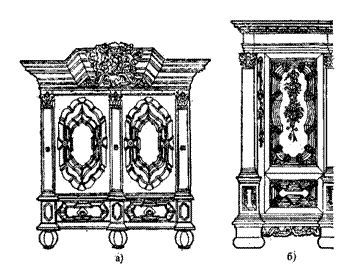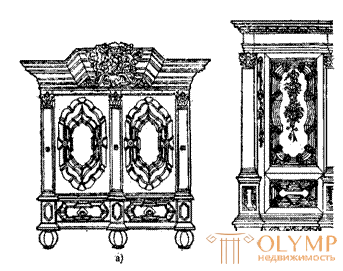
Baroque interiors in Holland are completely different from the interiors of France. Oki reflect the everyday life of the Dutch bourgeois. The development of baroque forms of furniture in Holland begins in the 30s – 40s of the 17th century. Initially, the furniture uses the forms and principles of late Italian renaissance furniture. The flourishing culture of residential interior falls on the 40-70s of the XVII century. The furniture of this period is characterized by constructive clarity, energetic forms of chopped and turned parts. For Holland, it was not the decorative dress forms that were characteristic, but furniture that was comfortable in the home, corresponding to small living spaces. The lines and shapes of Dutch furniture are simple and concise.
In Holland, tables appear on turned legs in the form of balls or balusters, large double-wing wardrobes with strongly protruding curved cornices, columns or pilasters and ribbon designs, slides consisting of a chest of drawers and a glazed display cabinet for storing porcelain and glass products mounted on it. , beds with magnificent registration from expensive fabrics (velvet, silk, a damask). For seating used furniture, covered with woolen fabrics, and wicker.

Fig. 1. Danzig (a) and Frankfurt (b) cabinets of German baroque
In the last quarter of the seventeenth century. in Dutch furniture is noticeably influenced by China. The cabinet-cabinet on high legs with a mass of sliding and secret drawers, closed with double floor doors, was widely used. The first cabinets of this type were ordered by Dutch merchants in China, later they were made in Holland. The legs of the cabinet are twisted or turned according to a European pattern or of a purely Chinese type - a curved form, extending upwards. They end at the bottom of the bird's paw holding the ball. The latter type of legs served as a model for later furniture, not only in Holland itself, but also in a number of neighboring countries.
In Germany, the baroque forms of furniture penetrate from Italy and Holland. In German furniture of the end of the XVII - the beginning of the XVIII century. walnut wood is widely used, abundant carvings are used, and details are profiled vigorously. The northern and southern schools are clearly distinguished. In the north (Danzig, Hamburg), large monumental cabinets are made (Fig. 1, a) with a heavily protruding eaves fastened in the center and columns richly finished with panels.
South (center Nuremberg) is more susceptible to Italian influence. Greater popularity was won by Frankfurt cabinets (fig. 1, b) with rich carvings, elegant proportions. Decorate furniture with wood carving and bone inlay and metals.
Manufacturing of cabinets is developing in Germany. Especially famous were the cabinets that were made in the city of Augsburg. They were trimmed with a Florentine mosaic. They made special front furniture products, decorated with silver and a turtle. German masters instead of ebony used moraine pear. Sometimes these cabinets were decorated with carved Ormos (Ohrmuschl), a characteristic ornament that mimics the folds of the auricle, often used painting, then the surface of the cabinet was treated as a facade with windows, behind which landscapes are visible.
In the Bavarian city of Regensburg, more stringent cabinets were produced, whose smooth planes, made of colored wood, created the illusion of deep architectural perspectives.
In England, the Baroque style develops by the 60s of the XVII century. For the transition period from the late Renaissance to Baroque, there were characteristic straight turned legs, joined at the bottom by smoothly curved guts, bent legs, trimmed with carved panels with energetic rhythm-like ornament. The backs of chairs, armchairs and sofas are often woven over with reeds, which gives them greater lightness. During this period, a recliner with a soft back, seat and armrests appears, which has remained almost unchanged to this day. The art of furniture from this period is associated with the names of a major English architect, Christopher Wren, and a Grypling Gibbons stone and wood carver.
The flowering of English Baroque coincides with the rule of Queen Anne (1702-1714), and therefore it is often called the "style of Queen Anne". Furniture of this period is characterized by simplicity, soft lines, cleanliness of forms and clarity of construction. Black and red lacquer techniques are widely used in Chinese character, ornamental inlay, curved Igo-cabriole. The characteristic types of furniture are a cabinet with a lower honor decided in the form of a table; toilet table with a mirror standing on it.
At the end of the period (1714–1727), under the influence of China, forms of bamboo furniture (the Chamber style) developed.
Что бы оставить комментарий войдите
Комментарии (0)